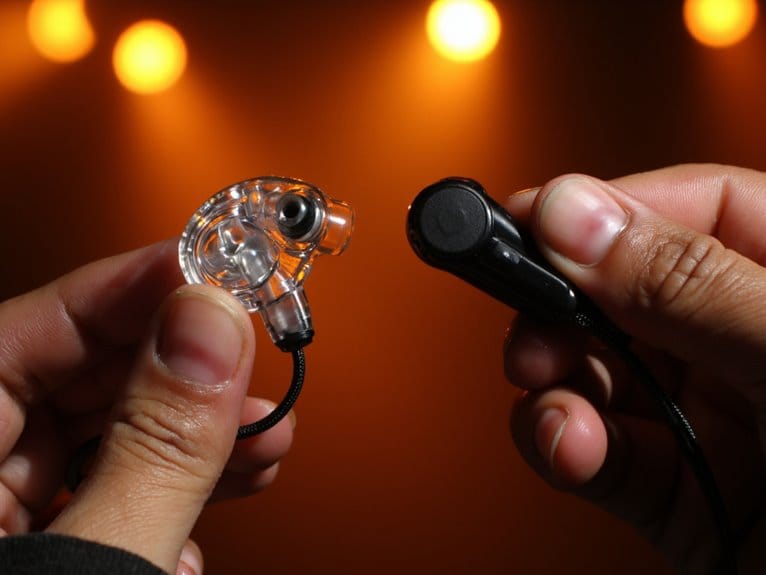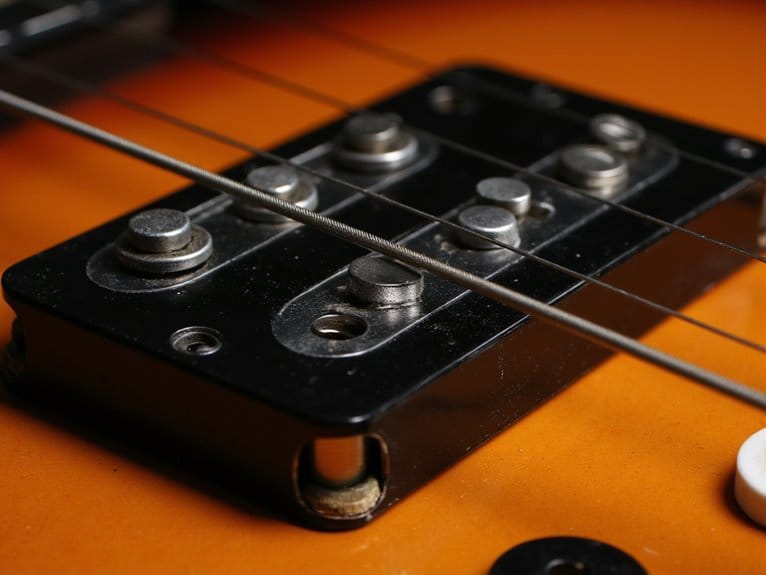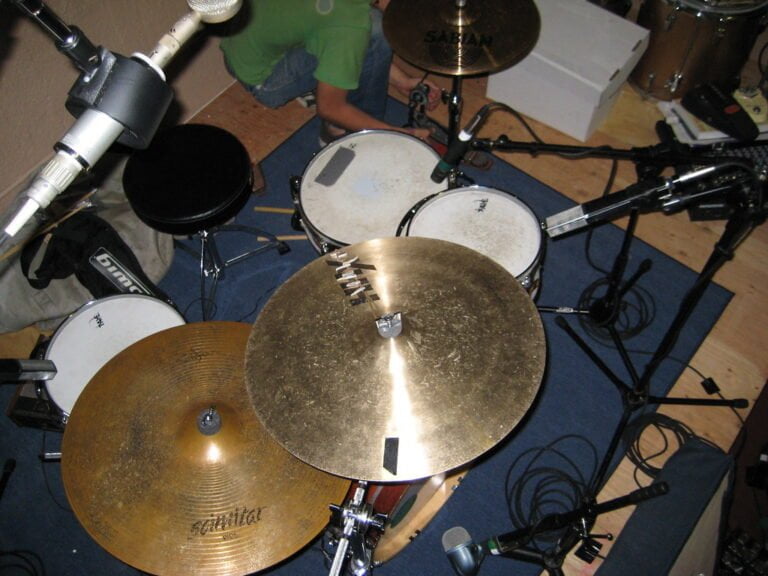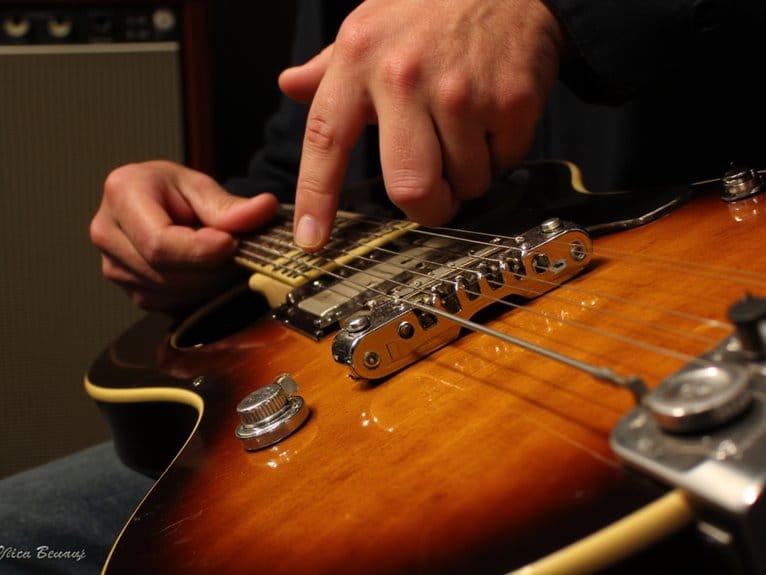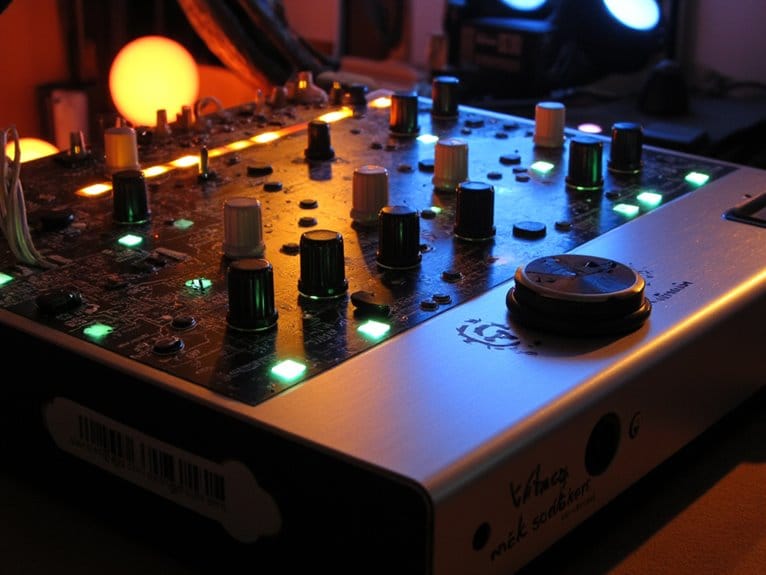How to Choose In-Ear Monitors for Live Performance
You’ll need to balance your budget ($45-150 offers excellent value), performance requirements (vocalists need crystal-clear presence, bassists require tight low-end), and physical comfort when selecting in-ear monitors for live performance. Consider multi-driver configurations with balanced armature or hybrid designs for wider frequency coverage, test different ear tip materials for proper acoustic seal, and choose between wired systems for zero latency or wireless for mobility. Understanding these fundamentals sets the foundation for making an informed decision that transforms your stage experience.
We are supported by our audience. When you purchase through links on our site, we may earn an affiliate commission, at no extra cost for you. Learn more.
Notable Insights
- Consider your instrument and role – vocalists need clear vocal presence while bassists require tight low-end reproduction for optimal performance.
- Choose multi-driver configurations with balanced armature or hybrid designs for wider frequency coverage and enhanced bass response with clear highs.
- Prioritize proper fit with quality ear tips and ergonomic shells to ensure acoustic seal, comfort, and up to 37dB noise isolation.
- Decide between wired systems for zero latency and audio fidelity versus wireless systems for superior mobility during dynamic performances.
- Target the $45-150 budget range for excellent value, as differences between mid-range and premium models are often subtle in live contexts.
Determining Your Performance Requirements and Primary Use Cases
When you’re standing on stage with amplifiers roaring and drums pounding behind you, choosing the right in-ear monitors becomes less about audiophile perfectionism and more about practical survival in a sonic battlefield.
Your performance environment dictates everything, from the wireless range you’ll need to the noise isolation required to cut through stage wash. Lead vocalists need crystal-clear vocal presence in their monitoring mix, while bassists require tight low-end reproduction to lock with the rhythm section. IEMs also help preserve hearing by allowing lower volume levels even in these loud environments.
If you’re switching between guitar and vocals mid-set, you’ll want adjustable mix capabilities that let you balance instruments and vocals on the fly, ensuring you can hear what matters most when it matters most. Professional models can provide up to 37dB of ambient noise blocking, transforming chaotic stage sound into surgical precision for critical monitoring decisions. Since IEMs sit deeper in the ear canal compared to standard earbuds, they create a more secure seal that’s essential for consistent monitoring during energetic stage performances.
Many professional IEMs feature hybrid driver configurations that combine balanced armature and dynamic drivers to deliver both the crystalline highs needed for detailed monitoring and the bass response crucial for rhythm section work.
Setting a Realistic Budget and Understanding Cost-to-Performance Ratios
Most musicians I’ve worked with over the years make the same costly mistake: they either blow their entire gear budget on expensive IEMs they don’t need, or they cheap out so aggressively that they end up replacing their monitors within six months.
Your budget allocation should reflect your actual performance prioritization rather than wishful thinking about what you might need someday.
Buy gear for the gigs you actually have, not the fantasy performances you dream about having someday.
Here’s what I’ve learned about cost-to-performance ratios:
- $45-150 range delivers excellent value for most live performers, with models like the Shure SE215 Pro providing reliable monitoring without breaking the bank
- Differences between $150 and $800 IEMs are often subtle in live contexts where stage noise and adrenaline dominate your focus
- Higher prices typically improve durability and fit options rather than dramatically enhancing your ability to hear the mix clearly
Smart budget discipline prevents overspending on marginal improvements. Budget-conscious performers can achieve professional-grade sound with models like the Linsoul KZ ZS10 Pro, which features a five-driver setup that rivals much more expensive alternatives.
The SENNHEISER IE 100 PRO utilizes a 10-mm dynamic driver that delivers warm, powerful sound specifically tuned for stage performance requirements.
Evaluating Fit, Comfort, and Ergonomic Design Features
After you’ve established your budget, you’ll need to focus on how your IEMs actually feel and stay put during those intense three-hour sets. I’ve learned the hard way that even the best-sounding monitors become useless if they’re sliding out mid-performance.
Your choice of ear tips-whether foam, silicone, or triple-flange-directly impacts both the acoustic seal and long-term comfort, while lightweight shells with ergonomic curves prevent the pressure points that’ll have you fidgeting instead of focusing on your music.
The shape of your IEMs matters more than you might think, since proper ergonomic design keeps them stable during movement, reduces cable noise through over-ear routing, and guarantees you can wear them for hours without that nagging discomfort that breaks your concentration. Quality IEMs with memory wire hooks provide the secure over-the-ear design that prevents slippage during energetic performances, ensuring your monitors stay locked in place when you need them most.
Proper Ear Tip Selection
How often have you struggled with in-ear monitors that won’t stay put or cause discomfort during long sets? Proper ear tip selection can make or break your live performance experience, and I’ve learned that starting with medium-sized tips gives you a solid baseline for testing fit and seal quality.
Size variability between manufacturers means you’ll need to experiment across different brands, since ear canals rarely match perfectly between your left and right ears.
The material impact on comfort becomes obvious during extended wear sessions, where silicone offers durability while foam provides superior conformity but less longevity.
- Test each ear independently with different sizes for ideal asymmetric fitting
- Play familiar audio while testing to evaluate sound isolation and bass response
- Use finger size as a rough guide for initial ear tip size estimation
Lightweight Design Benefits
When I’ve tested dozens of in-ear monitors during marathon recording sessions and live gigs, the difference between lightweight and heavier models becomes crystal clear within the first hour of wear.
You’ll notice reduced physical strain immediately, as lightweight materials like composite plastics eliminate the gradual ear fatigue that plagues heavier units.
The ergonomics importance becomes evident when you’re three hours into a performance – lighter IEMs maintain their secure fit without constant pressure adjustments, while heavier models start slipping or creating uncomfortable pressure points.
I’ve found that lightweight designs also reduce heat buildup considerably, preventing that clammy feeling that can distract during vital performance moments.
Your ears will thank you during those extended sets when every gram matters.
Ergonomic Shape Considerations
Beyond the weight factor, the actual shape of your in-ear monitors determines whether you’ll maintain comfort and performance quality throughout an entire show. The shell design needs to follow your ear’s natural anatomy, avoiding deep canal insertion that creates discomfort during extended wear.
I’ve found that ergonomic IEMs work best when they lock into your anti-tragus and concha areas, providing fit stability without excessive pressure.
Modern comfort factors focus on that “goldilocks zone” of moderate depth, balancing secure positioning with long-term wearability. Here’s what matters most:
- Custom molds provide personalized contours that eliminate pressure points
- Universal fits benefit from interchangeable tips and winged adapters
- Over-ear cable routing with memory wire prevents movement and pulling
Proper ergonomic shaping enhances your acoustic performance by creating better seals, maximizing passive isolation while keeping listening volumes safer.
Examining Build Quality, Durability, and Long-Term Reliability
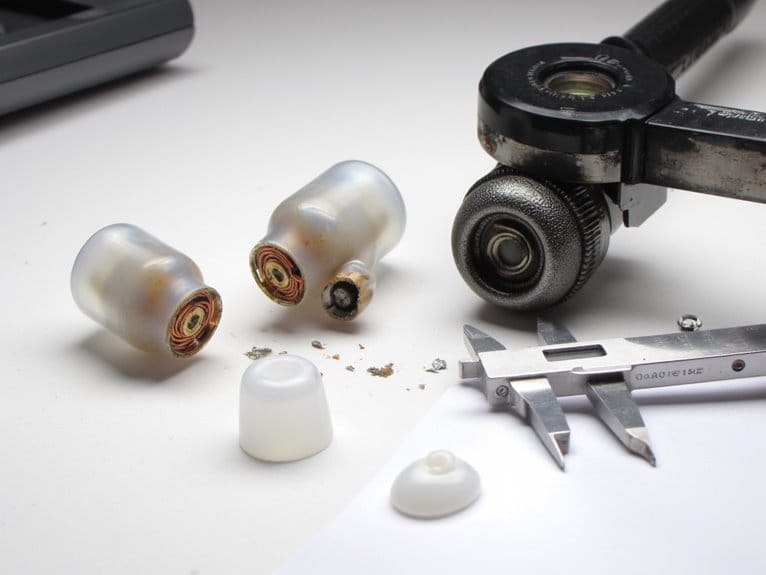
Professional musicians understand that even the most sonically impressive in-ear monitors become worthless investments if they can’t survive the rigorous demands of live performance, which is why I’ve learned to scrutinize build quality just as carefully as frequency response charts.
| Durability Factor | Budget Models | Professional Models |
|---|---|---|
| Cable Construction | Basic plastic sheathing | Reinforced Kevlar braiding |
| Connector Type | Standard 3.5mm jack | Locking MMCX or 2-pin |
| Water Resistance | None | IPX4-IPX7 rating |
| Strain Relief | Minimal protection | Reinforced boot design |
| Warranty Coverage | 30-90 days | 2+ years |
Material choice becomes critical when you’re dealing with sweat, humidity, and constant movement. I’ve witnessed countless IEMs fail from inadequate strain relief at connection points, while premium models with replaceable cables continue performing for years through proper maintenance and quality component selection.
Frequently Asked Questions
How Do I Prevent Ear Infections When Sharing IEMS With Other Musicians?
You’ll prevent infections by following strict ear hygiene tips: disinfect IEMs with alcohol before sharing, use personal disposable tips, and apply proper IEM cleaning techniques weekly. Always clean between users.
What’s the Difference Between Custom-Molded and Universal-Fit In-Ear Monitors?
Custom molded advantages include superior fit, better sound isolation, and enhanced audio quality tailored to your ears. Universal fit convenience offers cost-effectiveness, immediate availability, and sharing capability without needing custom impressions.
Do I Need a Separate Monitor Engineer for My IEM Setup?
You’ll benefit from a monitor engineer for complex IEM setups with multiple transmitters and frequency coordination. Monitor engineer roles include mix optimization and troubleshooting, while IEM setup benefits increase markedly with professional oversight and management.
On a final note
You’ve now got the roadmap for selecting IEMs that’ll actually work for your performances, though I’ll admit the sheer number of options can still feel overwhelming. Remember, you’re investing in gear that needs to perform night after night, so don’t rush the decision. Take time to demo different models, prioritize your specific needs over flashy features, and choose monitors that’ll grow with your performing career rather than hold it back.

